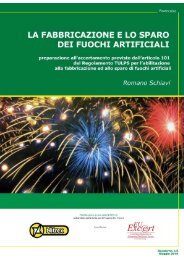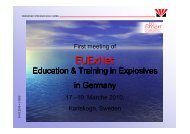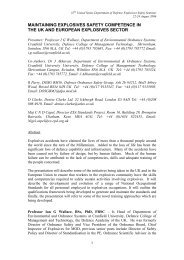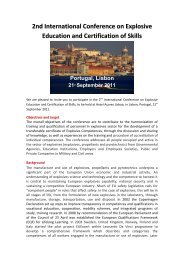Contents of Annexes Annex 1 List of Partners in EUEXcert Annex 2 ...
Contents of Annexes Annex 1 List of Partners in EUEXcert Annex 2 ...
Contents of Annexes Annex 1 List of Partners in EUEXcert Annex 2 ...
Create successful ePaper yourself
Turn your PDF publications into a flip-book with our unique Google optimized e-Paper software.
will be <strong>in</strong> all stages <strong>of</strong> life, from the formulation <strong>of</strong><br />
new explosives <strong>in</strong> the laboratory, through<br />
manufacture, storage, transportation, use and<br />
disposal.<br />
Thirty years ago explosives ordnance for U.K.<br />
armed forces was developed <strong>in</strong> MOD research<br />
labs, the explosives were synthesised and<br />
manufactured <strong>in</strong> MOD production facilities. There<br />
was a large and expert explosives quality<br />
assurance function, the Ordnance Board and CINO<br />
had more than 400 safety specialists to assure<br />
safety. In the armament depots and Air Force<br />
bases there was a cadre <strong>of</strong> ordnance and<br />
explosives specialists. Another substantial group<br />
<strong>of</strong> explosives specialists were employed on the<br />
nuclear weapons programme. Many <strong>of</strong> the<br />
competent staff <strong>in</strong> place today derived their<br />
experience and competence dur<strong>in</strong>g this period<br />
when they had one employer (the MOD).<br />
Today the situation is very different.<br />
Manufacture and production are firmly <strong>in</strong> the<br />
private sector and more recently, much <strong>of</strong> the<br />
explosives and ordnance research community has<br />
made a similar transition. Nuclear weapons are<br />
produced <strong>in</strong> privatised facilities. There is limited<br />
movement <strong>of</strong> staff between these different<br />
organisations and it is difficult for MOD to recruit<br />
or develop explosive specialists with broad<br />
experience. The general contraction <strong>of</strong> the<br />
explosives bus<strong>in</strong>ess <strong>in</strong> the U.K. has had a major<br />
impact on the numbers <strong>of</strong> skilled specialists.<br />
Added to this many <strong>of</strong> the U.K. specialists were<br />
recruited dur<strong>in</strong>g a growth period <strong>in</strong> defence<br />
science and technology <strong>in</strong> the 1970s and are<br />
approach<strong>in</strong>g retirement. A lack <strong>of</strong> recruitment <strong>in</strong><br />
the late 1970s and 1980s has left a demographic<br />
trough, where<strong>in</strong> there are <strong>in</strong>sufficient skilled<br />
explosives specialists to replace those who will be<br />
leav<strong>in</strong>g government service <strong>in</strong> the next few years.<br />
The picture <strong>in</strong> the rest <strong>of</strong> the European Union is<br />
similar. Many countries are report<strong>in</strong>g similar<br />
problems <strong>in</strong> f<strong>in</strong>d<strong>in</strong>g explosives specialists to fill<br />
key posts, especially <strong>in</strong> the explosives safety area.<br />
Scandanavian countries are also report<strong>in</strong>g that the<br />
shortage <strong>of</strong> skills is also affect<strong>in</strong>g the performance<br />
<strong>of</strong> explosives and ordnance related <strong>in</strong>dustries.<br />
However, it is not just a problem <strong>of</strong> shortage <strong>of</strong><br />
people, but a problem with the competence <strong>of</strong><br />
people already <strong>in</strong> the bus<strong>in</strong>ess.<br />
2 LEONARDO DA VINCI PROGRAMME<br />
Cranfield University together with KCEM, a<br />
Scand<strong>in</strong>avian explosives competence organisation,<br />
have jo<strong>in</strong>ed with other EU partners <strong>in</strong> a project<br />
funded by the European Union Leonardo da V<strong>in</strong>ci<br />
programme. This programme is aimed at<br />
replenish<strong>in</strong>g explosives expertise, though<br />
vocational tra<strong>in</strong><strong>in</strong>g and education across the EU.<br />
The purpose is not only to ensure the supply <strong>of</strong><br />
specialists <strong>in</strong> key explosives safety functions, but<br />
also to ma<strong>in</strong>ta<strong>in</strong> European competitiveness <strong>in</strong> the<br />
ordnance and explosives <strong>in</strong>dustrial sector.<br />
To achieve this purpose the project will:<br />
g) Identify the competencies required to<br />
susta<strong>in</strong> a safe and competitive explosives<br />
<strong>in</strong>dustry <strong>in</strong> the EU.<br />
h) Establish the current and future needs<br />
for these competencies <strong>in</strong> the EU.<br />
i) Develop tra<strong>in</strong><strong>in</strong>g and educational<br />
programmes designed to develop this<br />
range <strong>of</strong> competencies.<br />
j) Develop a range <strong>of</strong> novel education and<br />
tra<strong>in</strong><strong>in</strong>g packages that form part <strong>of</strong> the<br />
programme.<br />
k) Develop explosives qualifications which<br />
will be recognised and accepted across<br />
Europe<br />
l) Reverse the decl<strong>in</strong>e <strong>in</strong> expertise,<br />
knowledge and skill <strong>in</strong> European<br />
explosives bus<strong>in</strong>ess.<br />
The project is now <strong>in</strong> its second year and this<br />
paper highlights the results from activities which<br />
have been completed so far, together with<br />
activities planned for the forthcom<strong>in</strong>g year.<br />
2.1 Occupational Mapp<strong>in</strong>g<br />
In order to def<strong>in</strong>e the competencies <strong>of</strong> the workers<br />
<strong>in</strong> the explosives <strong>in</strong>dustries, the scope <strong>of</strong> the<br />
explosives occupational sector must first be<br />
established. Cranfield university together with the<br />
MoD and other <strong>in</strong>dustrial companies approached<br />
the Science, Eng<strong>in</strong>eer<strong>in</strong>g and Manufactur<strong>in</strong>g<br />
Technology Agency (SEMTA), which is one <strong>of</strong><br />
the UK Sector Skills Councils (SSC) (more<br />
<strong>in</strong>formation on SEMTA and the SSC is given <strong>in</strong><br />
section 3.1).<br />
SEMTA together with Denise Clark Ltd were<br />
asked to develop the national occupational<br />
standards and national vocational qualifications for<br />
occupations <strong>in</strong> explosive substances and articles<br />
with the help <strong>of</strong> Cranfield University, U.K. MoD<br />
and other organisations. Denise Clark Ltd carried<br />
out the follow<strong>in</strong>g occupational and functional<br />
maps, together with the competencies.<br />
An occupational mapp<strong>in</strong>g analysis has been<br />
carried out on all <strong>of</strong> the jobs <strong>in</strong>volv<strong>in</strong>g work with<br />
explosives with<strong>in</strong> the U.K. The occupational<br />
mapp<strong>in</strong>g analysis gives <strong>in</strong>formation on:<br />
• the numbers employed <strong>in</strong> each <strong>in</strong>dustry<br />
as a whole<br />
50













